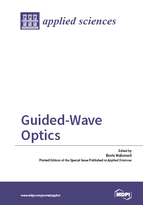Guided-Wave Optics
A special issue of Applied Sciences (ISSN 2076-3417). This special issue belongs to the section "Optics and Lasers".
Deadline for manuscript submissions: closed (15 March 2017) | Viewed by 97595
Special Issue Editor
Interests: nonlinear optics; matter waves; Bose-Einstein condensates; solitons; nonlinear waves; pattern formation in nonlinear dissipative media; long Josephson junctions
Special Issues, Collections and Topics in MDPI journals
Special Issue Information
Dear Colleagues,
The topic of guided wave (GW) propagation comprises a vast research area overlapping with photonics, matter waves in macroscopic quantum media (ultracold gases of bosonic and fermionic atoms, condensates of quasiparticles, such as excitons-polaritons, magnons, and cavity photons), hydrodynamics, acoustics, plasma physics, etc. In many situations, tightly confined GWs naturally acquire high amplitudes, which gives rise to a plenty of fascinating nonlinear effects. In particular, waveguides often provide a combination of nonlinearity, group-velocity dispersion, and low losses, which are necessary for the creation of solitons (robust solitary waves). In optics, experimental and theoretical work with GWs is a vast research area, with great significance both for fundamental studies and numerous applications, which are realized in linear and nonlinear forms alike, including long-haul telecommunications, all-optical data-processing schemes, and generation of powerful laser beams, especially in fiber lasers. More recently, new artificially created optical media have been made available, such as photonic crystals, metamaterials, photonic topological insulators, PT-symmetric waveguides, and others, which opens a way to implement GW propagation regimes with features that were not known previously – e.g., the propagation immune to scattering on defects, or light diodes, admitting strictly unidirectional transmission. Closely related to optical waveguides are their plasmonic counterparts, which admit the implementation of the GW transmission on much smaller scales, by using surface-plasmon-polaritonic waves with small wavelengths. Completely new perspectives for the exploration and application of GWs emerge in the area of nanophotonics, with the guided propagation carried out in photonic nanowires whose confinement length is essentially smaller than the optical wavelength.
The present Special Issue is devised as a collection of articles reporting both concise reviews of recently obtained results, and new findings produced in this broad research area. The topics are not limited strictly to traditional optics, but are assumed to address related fields, such as photonic in general (including plasmonics) and guided matter waves in quantum gases.
Prof. Boris Malomed
Guest Editor
Manuscript Submission Information
Manuscripts should be submitted online at www.mdpi.com by registering and logging in to this website. Once you are registered, click here to go to the submission form. Manuscripts can be submitted until the deadline. All submissions that pass pre-check are peer-reviewed. Accepted papers will be published continuously in the journal (as soon as accepted) and will be listed together on the special issue website. Research articles, review articles as well as short communications are invited. For planned papers, a title and short abstract (about 100 words) can be sent to the Editorial Office for announcement on this website.
Submitted manuscripts should not have been published previously, nor be under consideration for publication elsewhere (except conference proceedings papers). All manuscripts are thoroughly refereed through a single-blind peer-review process. A guide for authors and other relevant information for submission of manuscripts is available on the Instructions for Authors page. Applied Sciences is an international peer-reviewed open access semimonthly journal published by MDPI.
Please visit the Instructions for Authors page before submitting a manuscript. The Article Processing Charge (APC) for publication in this open access journal is 2400 CHF (Swiss Francs). Submitted papers should be well formatted and use good English. Authors may use MDPI's English editing service prior to publication or during author revisions.
Keywords
- waveguides
- optical fibers
- confinement
- group-velocity dispersion
- solitons
- photonic crystals
- surface plasmon polaritons
- nanowires
- guided matter waves






